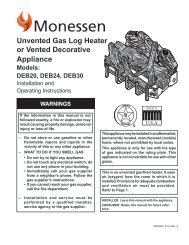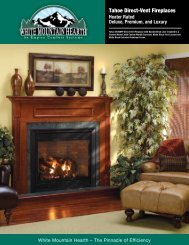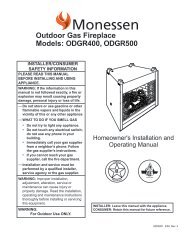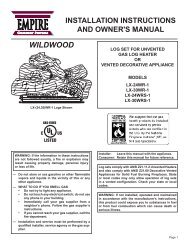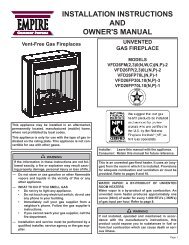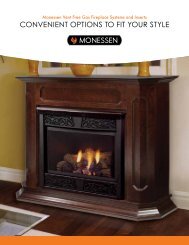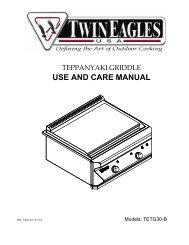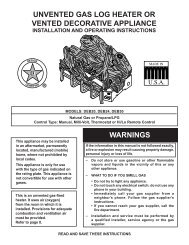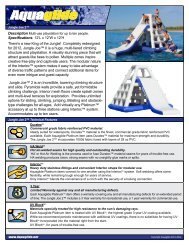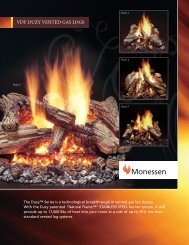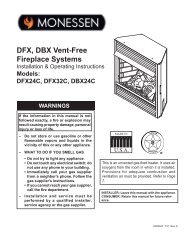Manual - Unvented Gas Log Heater or Vented Decorative Appliance
Manual - Unvented Gas Log Heater or Vented Decorative Appliance
Manual - Unvented Gas Log Heater or Vented Decorative Appliance
- No tags were found...
Create successful ePaper yourself
Turn your PDF publications into a flip-book with our unique Google optimized e-Paper software.
cleaning and maintenance<br />
BLDV7 Series <strong>Gas</strong> Fireplace<br />
WARNING<br />
Turn off gas bef<strong>or</strong>e servicing fireplace. It<br />
is recommended that a qualified service<br />
technician perf<strong>or</strong>m these check-ups at the<br />
beginning of each heating season<br />
Signature<br />
Command<br />
System Pilot<br />
Sens<strong>or</strong><br />
Thermopile<br />
Burner, Pilot and Control Compartment<br />
Keep the control compartment, logs, and burner areas<br />
surrounding the logs clean by vacuuming <strong>or</strong> brushing at<br />
least twice a year. Make sure the burner p<strong>or</strong>ting, pilot air<br />
opening and burner air opening are free of obstructions<br />
at all times.<br />
Pilot Flame<br />
The flames from the pilot should be visually checked as<br />
soon as the heater is installed and periodically during<br />
n<strong>or</strong>mal operation. The pilot flame must always be present<br />
when the fireplace is in operation. Figure 51. The<br />
pilot flame has three distinct flames, one engulfing the<br />
thermopile, one engulfing the thermocouple <strong>or</strong> sens<strong>or</strong>, and<br />
the other reaching to the main burner.<br />
burner<br />
Inspect area around the inject<strong>or</strong>. Remove any lint <strong>or</strong> f<strong>or</strong>eign<br />
material with a brush <strong>or</strong> vacuum.<br />
Burner Flame<br />
The flames from the burner should be visually checked<br />
as soon as the heater is installed and periodically during<br />
n<strong>or</strong>mal operation. In n<strong>or</strong>mal operation, at full rate, and<br />
after operating f<strong>or</strong> about 15 to 30 minutes, the flame<br />
should be yellow and slightly taller than the rear log.<br />
Figure 52<br />
If the flame is blue and only in the center, turn off unit<br />
and let cool. After unit is cool, remove logs and check to<br />
make sure the back holes in the burner are not covered<br />
with rock wool. If the back holes are clear, add m<strong>or</strong>e rock<br />
wool to the center of the burner. Replace logs.<br />
NOTE: The type of installation, vent system<br />
configuration, and wind effects may cause the flame<br />
patterns to vary.<br />
Millivolt<br />
Control<br />
Pilot<br />
Figure 51 -<br />
Pilot Flame<br />
Thermocouple<br />
FP1943<br />
pilot flame<br />
FP1943<br />
FP2453<br />
Thermopile<br />
FP2453<br />
hooded pilot flames<br />
Figure 52 -<br />
Burner Flame Appearance<br />
44<br />
LG647<br />
BLDV log flames<br />
LG647<br />
74D3000



